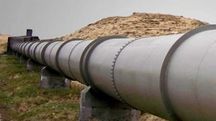Antarctica's Mount Erebus volcano emits 2.8oz gold per day
Scientists have confirmed that Mount Erebus, the highest active volcano in Antarctica, spews out gold dust daily. The volcano, which has been continuously erupting since 1972, is reported to emit about 2.8 ounces of gold daily, worth around $6,000.
 Mount Erebus, Antarctica's highest active volcano, emits gold dust daily.
Mount Erebus, Antarctica's highest active volcano, emits gold dust daily.In a remarkable discovery, scientists have found that Mount Erebus, the highest active volcano in Antarctica, is emitting gold particles along with volcanic gases. This finding, which sheds light on a phenomenon first observed by American geologists in 1991, underscores the unique geological activity of the region.
According to researchers, the detection of gold particles in volcanic gases emitted by Mount Erebus, as well as in surrounding snow, remains consistent with observations made three decades ago. The daily output of gold from the volcano is estimated to be approximately 2.8 ounces (80 grams), a figure consistent with previous findings.
Philip Kyle from the New Mexico Institute of Mining and Technology explained that gold deposits can originate in volcanic rock. When lava from Mount Erebus emits hot gas during volcanic activity, it carries some of these gold particles into the air. The size of the gold flecks ranges from 0.1 to 20 micrometers in the volcanic gases and approximately 60 micrometers in surrounding snow.
Situated on Ross Island in Antarctica, Mount Erebus is one of the region's 138 active volcanoes. Along with Deception Island, it is one of only two active volcanoes in the area. The volcano's daily emission of gold dust, valued at $6,000, highlights its significance in the geological landscape of Antarctica.
The volcano holds historical significance as well, notably due to the tragic event in 1979 when Air New Zealand Flight 901 crashed into its side, resulting in the loss of all passengers and crew.
Recent reports from the National Aeronautics and Space Administration (NASA) Earth Observatory reveal that gold dust from Mount Erebus has been detected as far as 621 miles from its southernmost lava-spewer. NASA notes that the volcano regularly emits plumes of gas and steam and occasionally spits out rocks (bombs).
Conor Bacon of Lamont-Doherty Earth Observatory at Columbia University highlighted that Mount Erebus has been continuously erupting since 1972. He noted the presence of a rare "lava lake" at one of its summit craters, explaining that such formations require specific conditions to prevent surface freezing.
Despite the advancements in understanding Erebus's activity, researchers face challenges in comprehending the potential events that could activate the other hundred-plus icy volcanoes in Antarctica. The limited number of permanent monitoring instruments, primarily consisting of seismometers, pose logistical challenges for conducting extensive studies on these remote volcanoes.
Bacon emphasized the importance of deploying temporary instrument networks for specific studies but acknowledged the logistical hurdles compared to more accessible volcanoes elsewhere in the world.
Copyright©2026 Living Media India Limited. For reprint rights: Syndications Today









